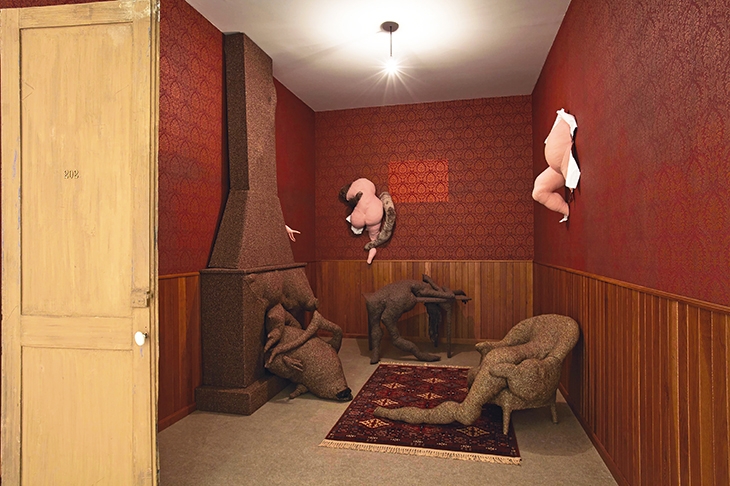Art movements come and go but surrealism, in one form or another, has always been with us. Centuries before Freud’s scientific observation that the stuff of dreams will out, artists were painting it.
The English have never been much cop at surrealism — too buttoned up; the Celts are better. The Scottish painters Alan Davie and John Bellany, jointly celebrated in Newport Street Gallery’s latest show, Cradle of Magic, were both surrealists in different ways. Both attended Edinburgh College of Art — Davie in the late 1930s, Bellany in the early 1960s — and both came out fighting in a punchy style of painting combining expressionistic brushwork with strong colour. Davie, also a free jazzer, subscribed to the surrealist belief that automatism unlocks inspiration, so the faster you paint and the less you think the better. Arming himself with an arsenal of Celtic symbols, he attacked his canvases on the floor with bucketloads of paint. The younger Bellany was more old-fashioned. He consulted his imagination, drawing on a store of memories and — before his liver transplant of 1988 — a bucketload of booze.
Bellany’s career was shorter, but his art has worn better. Given a gallery to themselves Davie’s paintings get repetitive, like a showroom of carpets woven by a Mexican on peyote, then torn up and patched back together in the dark. True, they have creative energy and a signature style, but what do all the primordial insignia — the diamonds, horseshoes, chevrons, wheels, boomerangs, snakes and squiggles — signify? I liked the less congested canvases such as ‘Dolly Scent’ (1962), which look like the work of a talented graffitist, though I’m not convinced they’re more than a posh form of tagging. As Bellany said of his own painting: ‘The imagery always comes, but it’s whether you make it meaningful. And often you don’t …it just becomes paint.’
Bellany’s work is a different kettle of fish. Not expecting shamanic inspiration, he looked at other artists: his powerful early ‘Crucifixion’ (1963) substitutes haddocks for the hanging beef carcasses in Francis Bacon’s ‘Figure with Meat’. The choice wasn’t random, there was a personal connection: the fish, gulls and boats that recur in Bellany’s work are not borrowings from an album of sacred emblems, they’re memories of Port Seton where his father was a fisherman. Some paintings, like ‘Rose of Sharon’ (1973), echo Max Beckmann, others like ‘Vesperland’ (1981), with its gull and skull fighting over a fish skeleton, smack of James Ensor. Ensor’s cadaverous heads also hang over ‘My Grandmother in Bed’ (1971), a touching portrait of a much-loved relative, small, calm and collected in the face of death.
Can art be separated from biography? In a film at the end of her exhibition at Tate Modern, Dorothea Tanning confesses: ‘I’ve done everything I could to escape my biography, but I think we’re prisoners of our events.’ It didn’t help that Tanning spent 30 years married to Max Ernst, nor that she was labelled early on as a woman surrealist. Ernst selected her topless self-portrait ‘Birthday’ (1942) for his third wife Peggy Guggenheim’s Exhibition by 31 Women in New York in 1943. Three years later, she was the fourth Mrs Ernst.
Tanning later jettisoned the woman artist label but stuck with the surrealism. Early works like ‘Eine Kleine Nachtmusik’ (1943), with its two Tennielesque little girls threatened by a monstrous sunflower in a hotel corridor, are painted in a tight hyperrealist technique. But being self-taught, she was curious about the ‘many ways paint can flow on to canvas’. By the 1960s she had burst free of the trammels of detail into a riotous rococo style suggesting orgies of entwined limbs seen through clouds of steam. In ‘Mean Frequency (of Auroras)’ (1981), a tangle of cancan legs emerges from a froth of gauze nestled in the crook of a crescent moon. Maintaining this degree of fluidity meant sloshing on the turps, which got up her nose, so in the late 1960s she turned to stitching stuffed versions of her surreal figures on her trusty Singer. ‘The sculptures came up out of a sort of rage,’ she says in the film, ‘all out of that crazy sewing machine.’
That crazy sewing machine completely liberated her. The soft sculptures punctuating the show’s last rooms and bursting out of the gilded wallpaper in her installation ‘Hôtel du Pavot, Room 202’ (1970–73) are wonderful: wicked, humorous, high-spirited, never creepy like a Hans Bellmer doll and far more cuddly. ‘Embrace’ (1969), with its brown fake-fur monster in a clinch with a headless, impossibly bendy pink flannel nude, reads like a fabulous pisstake of Picasso. At the time, people warned her against making soft sculptures, saying they wouldn’t last. Her response was: ‘But when you fall in love you don’t ask, how long will you live?’ She lived until 2012, aged 101, and her sculptures survive her.






Comments